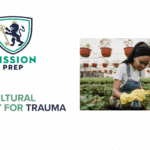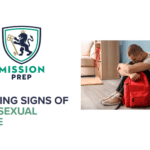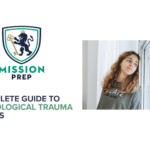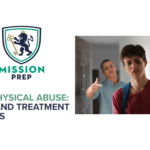What Is Family Enmeshment? Signs of Enmeshed Family Dynamics and How to Heal

As parents, one of our hopes is to have close, connected relationships with our teenage child. But sometimes this closeness can cross a line.
Many well-meaning parents can fall into enmeshed family patterns without even realizing it. Emotional boundaries may become blurred, personal space becomes non-existent, and your child’s independence can feel like a threat rather than a healthy sign of growth.
If you struggle to let your teen make their own mistakes or feel overwhelmed by their emotions, know that you’re not alone – and support is available. In this article, you’ll find family enmeshment trauma explained in clear, compassionate terms, as it covers:
- What healthy family dynamics look like
- What family enmeshment is
- What causes enmeshment
- Signs of enmeshment
- Mental health impact of family enmeshment on a teen’s attachment and identity
- Therapy for enmeshment trauma

Healthy Family Dynamics
Positive emotional bonds- Commitment
- Effective communication
- Shared quality time
- Healthy coping skills
- Spiritual well-being.
Having a healthy family dynamic can provide a teenager with the love, support, stability, and guidance they require to grow and explore the world with confidence. It can boost self-esteem, allow them to feel loved and safe, and encourage the development of their own individual values.2
What Is Family Enmeshment?
In real terms, this means that someone has a less distinct sense of self. As a result, they are unable to fully understand and value their own thoughts, feelings, and needs. Instead, they may look to other family members to make decisions and manage their emotions for them.
Additionally, enmeshed members of a family often find they are overly involved in each other’s lives and problems due to a lack of healthy boundaries. Parents may rely on their children for emotional support, and children may become excessively dependent on parents to fulfill their emotional needs.5
As you can see, family enmeshment presents itself quite differently from healthy family dynamics. But what causes a family to become enmeshed? We explore this next.
What Causes Enmeshment?
Secondly, enmeshment can arise from childhood trauma or illness. For example, a severely ill child may be overprotected by their parents, or someone with mental health struggles may have boundary issues.6
Ultimately, enmeshment is caused by a blurring of boundaries in the family, often completely unintentionally. However, this doesn’t mean it can’t be changed. Recognizing the signs of enmeshment is an important first step toward creating healthier family dynamics.
Signs of Enmeshed Family Dynamics in Parenting
Signs of being a parent in an enmeshed family include:7,8
Expecting your child to follow the same beliefs and values as you- Centering your life around the life of your teen
- Needing to know and be involved in everything in your child’s life
- Discouraging your child from following their dreams
- Prioritizing your needs over those of your child
- Fixing your self-worth on your child’s successes
- Relying on your child for emotional support
- Sharing personal information with your teen that should remain private
- Feeling like your relationship with your child is more of a friendship than a parent-child dynamic
- Lacking physical and emotional boundaries
- Believing that your teen shouldn’t reach out to people outside of the family for support because you can provide everything they need
If some of the above points hit close to home, remember that being enmeshed doesn’t mean you are a bad parent. It often occurs without people meaning for it to happen. The good news is that once you recognize the signs, you can choose to work on altering family dynamics to reflect healthier boundaries. We’ll go into detail on how to do this later, but first, we’ll dive into the effects enmeshment can have on teens.
Enmeshment and Identity Struggles in Teens
Personal Identity
Being enmeshed means that a teen may struggle to create their own unique identity separate from their parents (individuation). For example, difficulties developing their own opinions, beliefs, and desires. Without a clear sense of who they are, their self-esteem can plummet. They may doubt their own value and ability, as their self-worth is often tied up with another person’s happiness. This can eventually lead to frustration, which may present itself either as withdrawing from people or lashing out at others.7
Boundaries and Relationships
A teen with family enmeshment is likely to have a fear of abandonment and mistrust others due to the overly close-knit family dynamics they have experienced. They may lack the ability to create healthy boundaries in relationships, having never seen them modeled growing up. Also, adolescents who grow up in an enmeshed family tend to avoid conflict, having learned that it wasn’t safe for them to disagree with their parents.5 Finally, they may find themselves in codependent relationships in adulthood. This is because they can feel relationally familiar with enmeshment, as this is what they are used to.7
Emotional Regulation
Adolescents with enmeshed family dynamics are often highly dependent upon their parents or family members to help them manage their emotions. Because of this, they may not have learned how to self-soothe – the process of calming yourself when upset or when difficult emotions arise.6 Research confirms the link between emotional dysregulation and family enmeshment, showing that enmeshed adolescents find it more difficult to tolerate distress.9
Mental Health
Research shows that enmeshment can increase the risk of depression, anxiety, stress, burnout, and overwhelm.6,8,10 This may be due to feeling a pressure to ignore their own desires and needs, instead prioritizing those of the family. Living like this can cause guilt, fear, and exhaustion from existing in a way that doesn’t reflect their true inner identity.
Enmeshment and Attachment Issues in Teens
Attachments are the emotional bonds that form during early childhood between an infant and their caregiver. The type of attachment created depends on how well the child’s needs were met during the first few years of life.11 For example, if a baby regularly cries out for their parent in distress, the way the caregiver responds can inform the attachment style the child goes on to develop.
If a child’s needs are consistently and accurately fulfilled, a secure attachment is likely to form. However, if caregivers are inconsistent, neglectful, or even abusive, an insecure attachment can form. These attachment styles essentially provide a template for how to regulate emotions and create emotional connections with others throughout life. There are four main types of attachment: secure, insecure-anxious, insecure-avoidant, and insecure-disorganized.12
Evidence suggests that an anxious attachment is significantly linked to enmeshment in families.6,8,10 This may be due to certain key elements of enmeshment, such as fear of abandonment or not having emotional needs met in the way that was needed.
It’s never too late to change family dynamics for the better. There are various options available when considering attachment repair in enmeshed families, which we shall look at in the next section.
Breaking the Cycle of Family Enmeshment
Healing attachment ruptures caused by family enmeshment is completely possible with the right support and guidance. You can find more information below about self-help and therapeutic approaches for breaking free of enmeshment.
Coping Strategies for Enmeshed Teens
There are techniques and skills you can develop to create healthier family dynamics and relationships. For instance, establishing clear boundaries is crucial so that everyone knows what their role is in the family and what is expected of them. Communication is also important, both for deciding and setting boundaries effectively, as well as being able to talk about your personal needs and wants with others in a safe way.
Discovering your own unique identity, separate from your family, is a significant step that can allow you to grow and thrive. Although these are skills you can work on at home, it can be difficult to change dynamics, especially if they have been in place for a long time. This is where professional support, such as therapy, comes into play.
Emotional Boundaries in Family Therapy
It’s important to heal the disrupted emotional bonds created during childhood when recovering from family enmeshment. Attachment-based family therapy can help move the family unit as a whole toward a healthier dynamic by repairing disrupted emotional connections. Sessions focus on building trust, creating safety, encouraging open communication, and rebuilding healthy attachments.
DBT for Family Enmeshment Recovery
Individual therapy can be useful for family members wanting to have one-to-one support from a therapist. Dialectical behavior therapy (DBT), in particular, can teach people emotional regulation, how to set healthy boundaries, and ways to improve relationships and communication.
Trauma-Informed Therapy for Family Issues
Trauma-informed therapy can be helpful for those who have attachment issues related to trauma in childhood, for example, people living with complex post-traumatic stress disorder (CPTSD). Trauma-focused therapy allows teens to process the trauma they experienced and manage any symptoms they have relating to the trauma, such as flashbacks.
Treatment Programs for Enmeshed Adolescents
For some, it can be difficult to heal from enmeshment trauma while they’re still in the environment where enmeshment happens. This is where residential treatment for family trauma teens can be helpful. Teens are offered a safe, structured, and supportive environment with round-the-clock supervision and care to enable them to focus solely on their recovery. During this time, they will have the opportunity to attend therapy, learn about their condition, discover new coping skills, and develop healthy boundaries with others.

Healing From Enmeshment With Mission Prep
Family enmeshment can feel confusing as a teen, but breaking the enmeshment chains and creating healthier dynamics is entirely possible with the right support. If you are concerned about your child’s relationships and boundaries, please know that you don’t have to figure things out on your own. We are here for you.
At Mission Prep, we specialize in treating teens with mental and emotional health challenges. With virtual, outpatient, intensive, and residential options available, we can support your teen in a way that feels right for them.
If you’re ready to take the next step toward healing, reach out today through our secure, confidential web form. We can break the cycle of family enmeshment together.
References
- Brown, C., Porta, C. M., Eisenberg, M. E., McMorris, B. J., & Sieving, R. E. (2020). Family Relationships and The Health and Well-Being of Transgender and Gender-Diverse Youth: A Critical Review. LGBT Health, 7(8), 407–419. https://doi.org/10.1089/lgbt.2019.0200
- Scott, E. (2025, July 2). How to have healthy family relationships with less stress. Verywell Mind. https://www.verywellmind.com/healthy-family-relationshps-and-stress-relief-3144541
- Bacon, I., & Conway, J. (2022). Co-dependency and enmeshment — a fusion of concepts. International Journal of Mental Health and Addiction, 21(6), 3594–3603. https://doi.org/10.1007/s11469-022-00810-4
- Coe, J. L., Davies, P. T., & Sturge-Apple, M. L. (2018). Family cohesion and enmeshment moderate associations between maternal relationship instability and children’s externalizing problems. Journal of Family Psychology, 32(3), 289–298. https://doi.org/10.1037/fam0000346
- Porrey, M. (2024, November 11). What is enmeshment, and how do you set boundaries? Verywell Health. https://www.verywellhealth.com/enmeshment-healing-steps-5223635
- Martin, S. (2023, July 26). The enmeshed family system: What it is and how to break free. Psych Central. https://psychcentral.com/blog/imperfect/2019/05/the-enmeshed-family-system-what-it-is-and-how-to-break-free
- Lewis, R. (2020, August 31). What is an enmeshed family? Healthline. https://www.healthline.com/health/enmeshed-family
- Sutton, J. (2025, April 9). Enmeshment: breaking free from overbearing relationships. PositivePsychology.com. https://positivepsychology.com/enmeshment
- Kivisto, K. L., Welsh, D. P., Darling, N., & Culpepper, C. L. (2015). Family enmeshment, adolescent emotional dysregulation, and the moderating role of gender. Journal of Family Psychology, 29(4), 604–613. https://doi.org/10.1037/fam0000118
- Baroncelli, C. M. C., Lodder, P., Van Der Lee, M., & Bachrach, N. (2025). The role of enmeshment and undeveloped self, subjugation and self-sacrifice in childhood trauma and attachment related problems: The relationship with self-concept clarity. Acta Psychologica, 254, 104839. https://doi.org/10.1016/j.actpsy.2025.104839
- McGarvie, S., PhD. (2025, March 27). Attachment Theory, Bowlby’s Stages & Attachment Styles. PositivePsychology.com. https://positivepsychology.com/attachment-theory/
- Ainsworth, M. D. S., & Bell, S. M. (1970). Attachment, exploration, and separation: Illustrated by the behavior of one-year-olds in a strange situation. Child Development, 41(1), 49–67. https://doi.org/10.2307/1127388



















